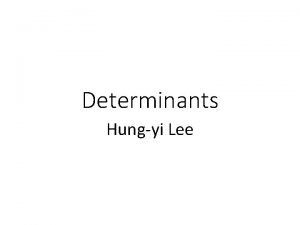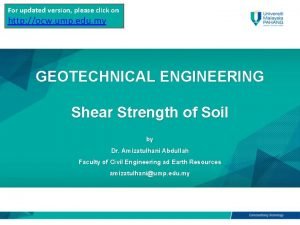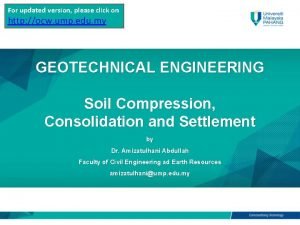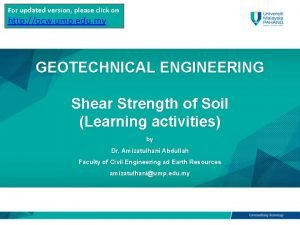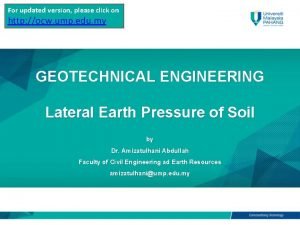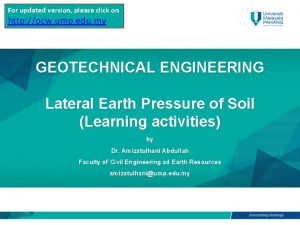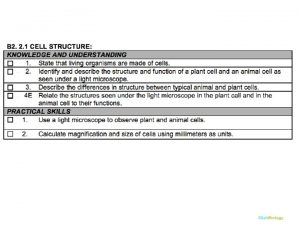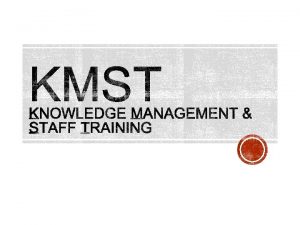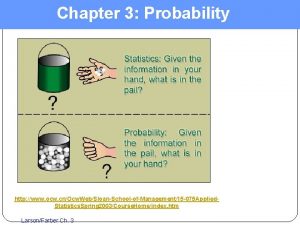For updated version please click on http ocw



































- Slides: 35

For updated version, please click on http: //ocw. ump. edu. my GEOTECHNICAL ENGINEERING Shear Strength of Soil by Dr. Amizatulhani Abdullah Faculty of Civil Engineering ad Earth Resources amizatulhani@ump. edu. my

Chapter description • Aims – This chapter provides further discussion and explanation related to shear strength of soil. • Expected Outcomes – Apply various method of laboratory test to evaluate shear strength of soil. • References – Das, B. M. , “Principles of Geotechnical Engineering, 5 th edition”, Thomson Learning (2002). – Budhu, M. , “Soil Mechanics and Foundations, 3 rd edition”, John Wiley and Sons (2010). – Liu, C. & Evett, J. B. , “Soils and Foundations, 7 th edition”, Prentice Hall (2008). – Whitlow, R. , “Basic Soil Mechanics”, Prentice Hall (2004). Shear Strength of Soil by Dr. Amizatulhani Abdullah

Content • Laboratory test to determine shear strength parameters ; Triaxial test, vane shear test, unconfined compression test • Stress path • Sensitivity and thixotrophy • Conclusion Shear Strength of Soil by Dr. Amizatulhani Abdullah

TRIAXIAL TEST Deviator load Confining cylinder Cell water Rubber membrane O-ring seals Soil Porous filter disc Cell pressure Shear Strength of Soil by Dr. Amizatulhani Abdullah Pore pressure and volume change

TEST PROCEDURE • • • Cylindrical soil specimen (wrapped in a rubber membrane) is subjected to a vertical load. This test require the present of the confining / lateral pressure. Specific value of confining pressure is achieved by introducing water or compressed air into the chamber to surround the soil specimen. The vertical load is applied and steadily increased until the specimen fails. The vertical load and the lateral pressure that cause the specimen failed is recorded. The test is repeated several times. Shear Strength of Soil by Dr. Amizatulhani Abdullah

TYPICAL RESULT Increasing cell pressure Shear Strength of Soil by Dr. Amizatulhani Abdullah

F = Deviator load r r = Radial stress (cell pressure) r a = Axial stress From equilibrium we have, Shear Strength of Soil by Dr. Amizatulhani Abdullah

• F/A is known as the deviator stress, and is given the symbol q where 1 = axial pressure / major principal stress 3 = lateral pressure / minor principal stress Shear Strength of Soil by Dr. Amizatulhani Abdullah

By plotting 1 and 3 in a graph, we can determine : 1. Cohesion, c 2. Angle of internal friction, HOW ? Shear Strength of Soil by Dr. Amizatulhani Abdullah

DATA ANALYSIS 1. 2. 3. 4. 5. Draw suitable axes (x and y) in a graph paper. The same scale should be used for both axes. Using 1 and 3 values obtained from several triaxial tests, draw a semicircle. Draw a straight tangent line (touch both semicircles, if possible) to the semicircles. The straight line is called the Strength Envelope @ Failure Envelope @ Mohr’s envelope. c value obtained from the y-axis while value obtained from the gradient of the strength envelope. Shear Strength of Soil by Dr. Amizatulhani Abdullah

t c 3 Shear Strength of Soil by Dr. Amizatulhani Abdullah 1

TYPES OF TRIAXIAL TEST There are many test variations. Those used most in practice are: o UU (unconsolidated undrained) test. Cell / lateral pressure is applied without allowing drainage. Then keeping cell pressure constant, increase deviator / axial load to failure without drainage. o CU (isotropically consolidated undrained) test. Drainage allowed during cell pressure application. Then without allowing further drainage increase deviator / axial load, keeping cell pressure constant as for UU test. o CD (isotropically consolidated drained) test. Similar to CU except that as deviator stress is increased drainage is permitted. Shear Strength of Soil by Dr. Amizatulhani Abdullah

Test type Step 1 Step 2 Consolidated drained, CD Apply chamber pressure, 3. Allow complete drainage, so pore water pressure (u = u 0) developed is zero Apply axial stress, , slowly. Allow drainage, so pore water pressure (u = ud) developed through application of is zero. At failure, = f ; total pore water pressure, uf = ua + ud = 0 Consolidated undrained, CU Apply chamber pressure, 3. Allow complete drainage, so pore water pressure (u = u 0) developed is zero Apply axial stress, . Do not allow drainage (u = ud 0). At failure, = f ; pore water pressure, u = uf = ua + ud = 0 + ud(f) Unconsolidated undrained, UU Apply chamber pressure, 3. Do Apply axial stress, . Do not allow drainage, so pore water drainage (u = ud 0). At failure, = pressure (u = u 0) developed f ; pore water pressure, u = uf = ua + through application of 3 is not ud(f) zero Shear Strength of Soil by Dr. Amizatulhani Abdullah

ADVANTAGES • • • Specimens are subjected to (approximately) uniform stresses and strains. The complete stress-strain-strength behavior can be investigated. Drained and undrained tests can be performed. Pore water pressures can be measured in undrained tests, allowing effective stresses to be determined. Different combinations of cell pressure and axial stress can be applied. Shear Strength of Soil by Dr. Amizatulhani Abdullah

WORK EXAMPLE The results of a trixial test are as follows : No of test Chamber confining pressure, k. N/m 2 Deviator stress at failure, k. N/m 2 1 2 3 100 200 300 210 438 644 Draw the shear strength envelope and determine the shear strength parameters of the soil. Shear Strength of Soil by Dr. Amizatulhani Abdullah

Solution : Hint : 1 = 3 + 1. Complete the following table. No of test 1 2 3 2. 3. 3, k. N/m 2 100 200 300 , k. N/m 2 210 438 644 1, k. N/m 2 Using the graph paper (same scale on both axis), draw the mohr envelope and sketch the tangent line. Check the interception on y-axis and the gradient of the line. Shear Strength of Soil by Dr. Amizatulhani Abdullah

UNCONFINED COMPRESSION TEST • A special type of UU test (triaxial test) that is commonly used for clay specimen. • σ3 = 0 • Axial load rapidly applied to the specimens to cause failure. • At failure the total minor principal stress is zero and total major stress is σ1 Shear Strength of Soil by Dr. Amizatulhani Abdullah

TYPICAL RESULT Shear Strength of Soil by Dr. Amizatulhani Abdullah

General Relationship of Consistency and Unconfined Compression Strength of Clays Consistency qu ton/ft 2 k. N/m 2 Very soft 0 – 0. 25 0 – 24 Soft 0. 25 – 0. 5 24 – 48 Medium 0. 5 – 1 48 – 96 Stiff 1– 2 96 – 192 Very stiff 2– 4 192 – 383 Hard 4 383 Shear Strength of Soil by Dr. Amizatulhani Abdullah

VANE SHEAR TEST Vane shear apparatus : consists of four thin, equal sized steel plates welded to a steel torque rod. Shear Strength of Soil by Dr. Amizatulhani Abdullah

Vane shear tester (Budhu, 2010) Shear Strength of Soil by Dr. Amizatulhani Abdullah

TEST PROCEDURE • • This test is used to determine shear strength of cohesive soils. Normally done in-situ on a soft clayey soil (cohesive soil). The vane is pushed into the soil. Torque, T is applied at the top of the torque rod to rotate the vane at a uniform speed. • A cylinder of soil (height h & diameter d) will resist the torque until the soil fails. where = coefficient of shear strength mobilization at the end of soil cylinder. = 1/2 @ 2/3 @ 3/5 Shear Strength of Soil by Dr. Amizatulhani Abdullah

• Bjerrum (1974) showed that as the plasticity of soils increases, cu obtained from VST may give results that are unsafe for foundation design. Therefore, he suggested that some correction should be made : cu (design) = cu (VST) where = correction factor = 1. 7 - 0. 54 log(PI) • Morris and Williams (1994) gave the correlations of as : = 1. 18 e-0. 08(PI) + 0. 57 (for PI 5) = 7. 01 e-0. 08(LL) + 0. 57 (for LL 20) Shear Strength of Soil by Dr. Amizatulhani Abdullah

OTHER METHOD TO DETERMINE SOIL’S SHEAR STRENGTH 1. Ring shear test 2. Cone penetration test Laboratory test (ASTM D 3441 and D 5778) 3. Standard penetration test (ASTM D 1586) 4. Penetrometer test Shear Strength of Soil by Dr. Amizatulhani Abdullah Field test

Stress path • A convenient way of plotting triaxial test data is through diagrams called stress paths. • Stress path = line that connects a series of point, each of which represents a successive stress state experienced by a soil specimen during the process of a test Stress path = diagrams/graphs of stress changes • Lamb (1964) suggested a new coordinate system of p’ versus q’ where, Shear Strength of Soil by Dr. Amizatulhani Abdullah

TYPES OF STRESS PATH 1. 2. 3. 4. Stress path in / space Stress path in 1/ 3 space Stress path in t’/s’ space Stress path in q’/p’ space Shear Strength of Soil by Dr. Amizatulhani Abdullah Advance level

Stress path for a consolidated drained triaxial test on a normally consolidated clay (Das, 2002) • Results of triaxial tests can be represented by stress path. • Consider a normally consolidated clay subjected to an isotropically consolidated-drained triaxial test. • At the beginning of the test, the deviatoric stress σ1’ = σ3, so, Shear Strength of Soil by Dr. Amizatulhani Abdullah

�and the p’ and q’ will plot as point I (in previous figure). As the load is increased, the deviatoric stress σ1’ = σ3’ + <σd and σ3’ = σ3, and the Mohr circle A corresponds to that state. �These two equations plot as point D’ at the top of the Mohr circle A. Shear Strength of Soil by Dr. Amizatulhani Abdullah

• Each successive plot of p’ and q’ will continue this straight line that is at an angle of 45° with respect to the p’ axis. • Eventually we will reach the point D on the Mohr circle B, and the sample fails (it has reached the modified failure envelope). • From this, q ' = p ' tanα Shear Strength of Soil by Dr. Amizatulhani Abdullah

Sensitivity & thixotrophy • For naturally deposited clay soils, unconfined compression strength is reduced greatly when the soils are tested after remolding without any change in moisture content. • This property is called sensitivity. • The loss of strength of clay soils due to remolding is primarily due to the destruction of the clay particle structure that was developed during the original process of sedimentation. • If, however, after remolding a soil specimen is kept in an undisturbed state (that is, without any change of moisture content), it will continue to gain strength with time. • This phenomenon is referred to as thixotropy. Shear Strength of Soil by Dr. Amizatulhani Abdullah

Sensitivity = the reduction in unconfined compression strength of clay soils due to remolding although no changes in the moisture content Degree of sensitivity, St = Shear Strength of Soil by Dr. Amizatulhani Abdullah

�may range from 1 to 8 or might be reached as high as 80 (flocculent marine clay deposits) Sensitivity, St (log scale) 1 2 Slightly sensitive 4 • 16 Very sensitive Medium sensitive • 8 32 Medium quick 64 Very quick Extra quick Slightly quick There are some clays that turn to viscous fluids upon remolding. These are found mostly in the previously glaciated areas of North America and Scandanavia. These clays are referred to as “quic” clays. Shear Strength of Soil by Dr. Amizatulhani Abdullah

Thixotrophy = is a condition whereby a soil specimen which is kept in undisturbed condition (after remolding) will experienced a continuous increased in strength with time. • • • The loss of strength is gradually regained with time when the materials are allowed to rest. However most soils are partially thixotropic (part of the strength loss caused by remolding is never regained with time) The soils strength will never achieved the initial strength although the specimen were prepared undisturbed. Shear Strength of Soil by Dr. Amizatulhani Abdullah

Conclusion • Conclusion #1 – There are several tests that can be use to determine shear strength parameters of soil (direct shear test, triaxial test, unconfined compression test and vane shear test). • Conclusion #2 (important terminology) – Stress path is a line that connects a series of point, each of which represents a successive stress state experienced by a soil specimen during the process of a test. – Sensitivity is the reduction in unconfined compression strength of clay due to remolding although there is no changes in moisture content. – Thixotrophy is a condition whereby a soil specimen which is kept in undisturbed condition (after remolding) will experienced a continuous increased in strength with time. Shear Strength of Soil by Dr. Amizatulhani Abdullah

Author Information Dr. Amizatulhani Abdullah Dr. Mohd Yuhyi Mohd Tadza Dr. Youventharan Duraisamy Dr. Muzamir Hasan Ir. Azhani Zukri
 Click clever click safe
Click clever click safe Click clever click safe
Click clever click safe Cyber safety
Cyber safety Click clever click safe
Click clever click safe During _____ branching, only car is updated with adr
During _____ branching, only car is updated with adr Performance monitoring and coaching form with answers
Performance monitoring and coaching form with answers Click on the button below
Click on the button below Nobody said anything raymond carver
Nobody said anything raymond carver Linear algebra
Linear algebra Camins ocw
Camins ocw Vu ocw
Vu ocw Henderson 2003
Henderson 2003 Tarkan gürbüz
Tarkan gürbüz Simak pasca ipb
Simak pasca ipb Ocw bu
Ocw bu Ocw
Ocw Ocw
Ocw Properties of determinants
Properties of determinants Metu computer center
Metu computer center Http //mbs.meb.gov.tr/ http //www.alantercihleri.com
Http //mbs.meb.gov.tr/ http //www.alantercihleri.com Siat.ung.ac.id krs
Siat.ung.ac.id krs Tillitsbaserad ledning
Tillitsbaserad ledning Varför kallas perioden 1918-1939 för mellankrigstiden?
Varför kallas perioden 1918-1939 för mellankrigstiden? Mästar lärling modellen
Mästar lärling modellen Rimma meningar
Rimma meningar Borstål, egenskaper
Borstål, egenskaper Verktyg för automatisering av utbetalningar
Verktyg för automatisering av utbetalningar Jag har nigit för nymånens skära text
Jag har nigit för nymånens skära text Jätte råtta
Jätte råtta Boverket ka
Boverket ka Strategi för svensk viltförvaltning
Strategi för svensk viltförvaltning Shivaiter
Shivaiter Sura för anatom
Sura för anatom Informationskartläggning
Informationskartläggning Slyngexcision
Slyngexcision Typiska novell drag
Typiska novell drag

















